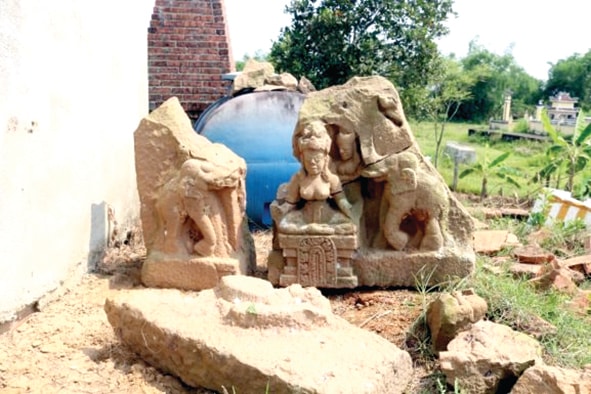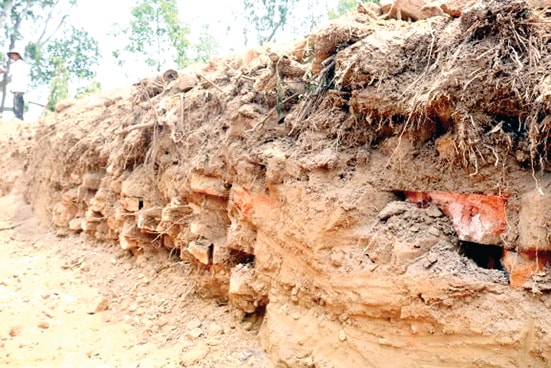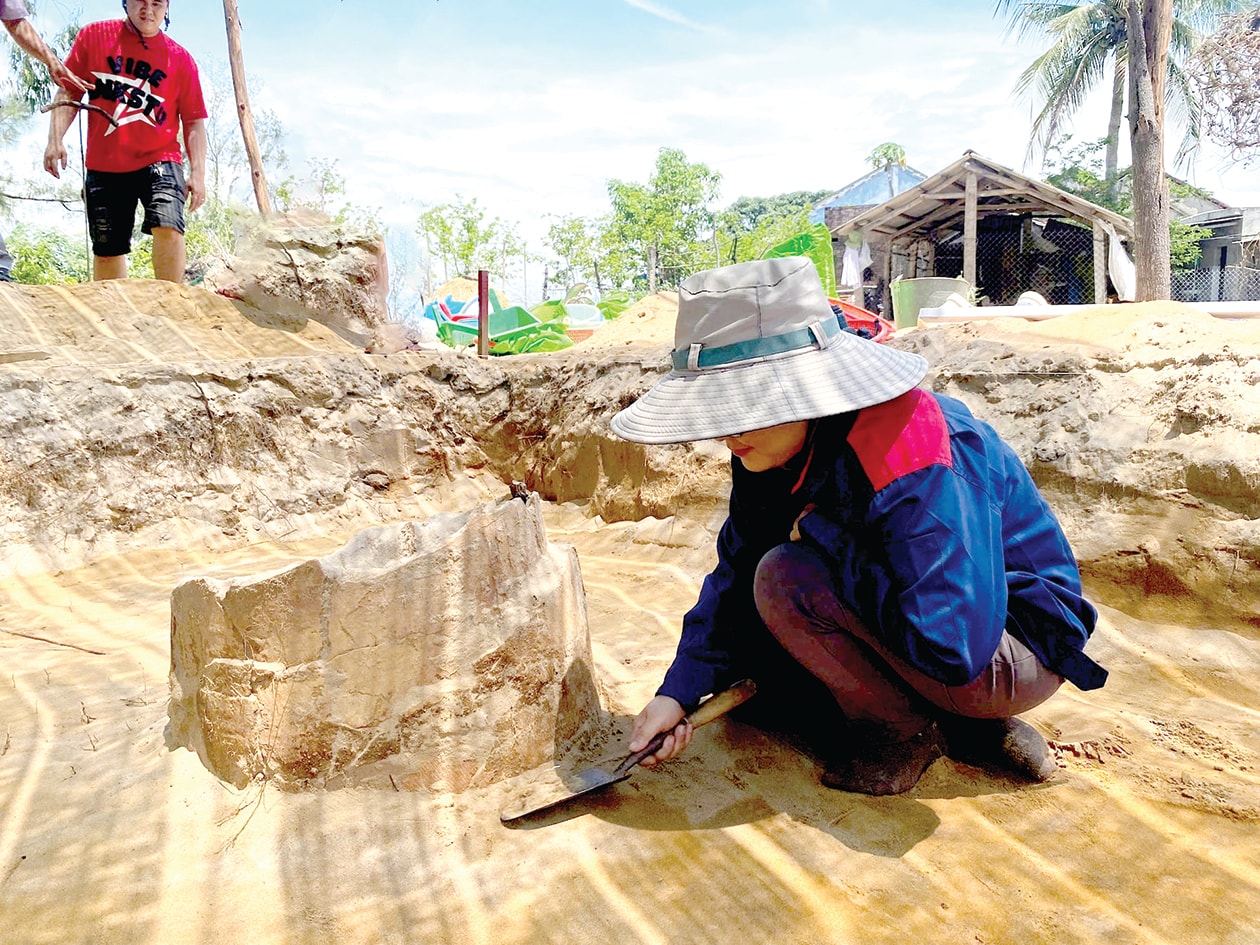
More Champa vestiges discovered
Along with the joy of discovery is the constant worry that the heritage is "bleeding" every day due to human encroachment and time.
And the concerns in building a general "archaeological plan" for the locality.
Along with the mysterious veil of Sa Huynh culture, the investigation and survey journey of researchers at Quang Nam Museum also brought new discoveries about Champa culture.
In La Tho 2 village, Dien Ban Bac ward, the survey team discovered an important Cham tower ruin at Ba Temple with many unique sandstone sculptures, notably a relief carving of three goddesses (Tridevi) and two elephants - the first artifact found in Champa culture and an almost intact Yoni pedestal in the Dong Duong style (9th - 10th century).
In particular, in Que Phuoc commune (formerly Phuoc Ninh commune, Nong Son district, Quang Nam province), the working group discovered a stele carved on natural stone in the Ho Nhi area. The stele consists of 6 lines of ancient Cham characters, which experts have tentatively determined to date from around the 9th - 11th century.
Together with the stone inscriptions in Samo, Tay Giang commune, 7th - 9th century, talking about the buffalo sacrifice ceremony, these discoveries are living evidence showing that the influence of the Champa kingdom spread deeply into the Truong Son region, revealing the legendary "salt road" connecting trade between the Cham people and indigenous peoples.
Many artifacts in communal houses, pagodas, archaeological sites and in people's homes were also inventoried, described and collected.
Specifically, the Champa Buddha statue made from sandstone, carved in a European-style sitting position at Hoa My Pagoda, Hoa My Village, Xuan Phu Commune, has the same posture as the large Buddha statue that French archaeologists excavated in the central room of Dong Duong Buddhist Institute.
Or the discovery of the Shiva statue in Loc Dai village, Que Son Trung commune (formerly Que Hiep commune, Que Son, Quang Nam) in the relic of the house of Vietnamese Heroic Mother Le Thi Suu; the discovery of two stone altars in An My I village, Tay Ho commune (formerly Tam An commune, Phu Ninh district, Quang Nam); many stone, bronze and ceramic artifacts at Thanh Luong pagoda, Duy Nghia commune (formerly Duy Hai commune, Duy Xuyen, Quang Nam)... These are discoveries of great value that need to be studied more deeply in the future.
The ancient Champa well system, with its unique construction technique of stone or brick without mortar, with wooden bottoms, continues to be recorded in many places such as Tam Ky, Dien Ban, Que Son, Duy Xuyen. Many wells are still used by people, becoming a symbol of the exchange and assimilation of Vietnamese - Cham culture on this land.
Heritage calls for help
Along with new discoveries, the results of the survey also sound an alarm about the current state of heritage conservation.

Most of the relics, from Sa Huynh burial sites to Cham ruins, are being seriously damaged. The looting of antiquities that has been going on for many years has mercilessly destroyed the relics. Jar burial sites in Go Dinh (Thuong Duc commune), Pa Xua (Ben Gieng commune), Binh Yen (Que Phuoc commune)... have been plowed and destroyed in search of agate and bronze, permanently losing valuable scientific information.
The process of socio-economic development is also creating great pressure on heritage. Land leveling for agricultural cultivation, acacia plantation, construction of infrastructure works and industrial zones has directly destroyed or distorted many archaeological sites.
The Go Ngoai jar burial site (Dai Loc commune), although ranked at the provincial level, was still leveled to build a transformer station. The Go Ma Voi site (Duy Xuyen) is also under threat due to the planning of the Tay An Industrial Park. The Ba Temple in Bich Tram village (Dien Ban Bac) has a brick architecture that has not been protected, excavated, or studied.
Even excavated relics such as Duong Bi tower, Tra Kieu citadel, An Phu tower... have not been properly protected, leading to the ruins continuing to deteriorate due to rain and sun.
Urgent action needed
Faced with the above situation, the report of Quang Nam Museum proposed many urgent solutions, first of all, to speed up the construction and promulgation of archaeological planning.

With the new Da Nang city space, the construction of a general archaeological planning is not only a legal requirement but also an important strategy. From an archaeological perspective, the consolidation is the return to a unified cultural space in history.
To manage, protect and promote this huge heritage treasure, a comprehensive, scientific and far-sighted archaeological plan is a tool and a key of strategic significance, helping to proactively identify and protect invaluable heritage against the pressure of urban development.
This planning plays a key role in harmonizing conservation and development, orienting sustainable construction, avoiding conflicts and wasting resources. More importantly, it turns heritage into assets, creates unique cultural tourism products, deepens historical and cultural identity and contributes to building a brand for a modern but richly developed Da Nang.
In addition, the survey team also recommended that it is necessary to immediately set up markers to mark protected areas at discovered relics, especially locations at high risk of encroachment.
For exposed ruins, urgent on-site preservation plans are needed, such as roofing, reinforcement, and erosion control.
Propaganda work, raising awareness in the community and encouraging people to hand over antiquities to the state is also a key task.
The priceless heritages underground in Quang Nam, if not protected in time, will disappear forever, leaving unfillable gaps in the historical flow of the nation.
Source: https://baodanang.vn/nghi-chuyen-ky-uc-tu-long-dat-3300869.html



![[Photo] Ho Chi Minh City is filled with flags and flowers on the eve of National Day September 2](https://vphoto.vietnam.vn/thumb/1200x675/vietnam/resource/IMAGE/2025/9/1/f493a66401844d4c90919b65741ec639)
![[Photo] National Assembly Chairman Tran Thanh Man receives Cambodian Senate President Hun Sen](https://vphoto.vietnam.vn/thumb/1200x675/vietnam/resource/IMAGE/2025/9/1/7a90c9b1c1484321bbb0fadceef6559b)

![[Photo] General Secretary receives heads of political party delegations from countries attending the 80th anniversary of our country's National Day](https://vphoto.vietnam.vn/thumb/1200x675/vietnam/resource/IMAGE/2025/9/1/ad0cb56026294afcae85480562c2e790)
![[Photo] People eagerly wait all night for the parade on the morning of September 2](https://vphoto.vietnam.vn/thumb/1200x675/vietnam/resource/IMAGE/2025/9/1/0cf8423e8a4e454094f0bace35c9a392)
![[Photo] Celebration of the 65th Anniversary of the Establishment of Diplomatic Relations between Vietnam and Cuba](https://vphoto.vietnam.vn/thumb/1200x675/vietnam/resource/IMAGE/2025/9/1/0ed159f3f19344e497ab652956b15cca)
































































































Comment (0)